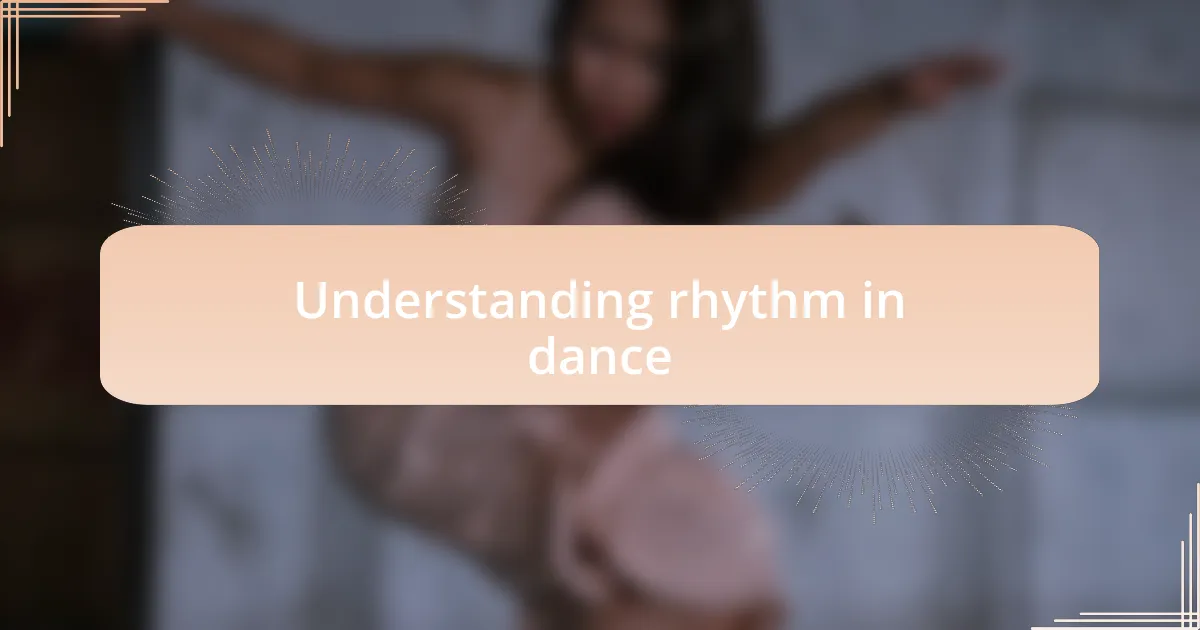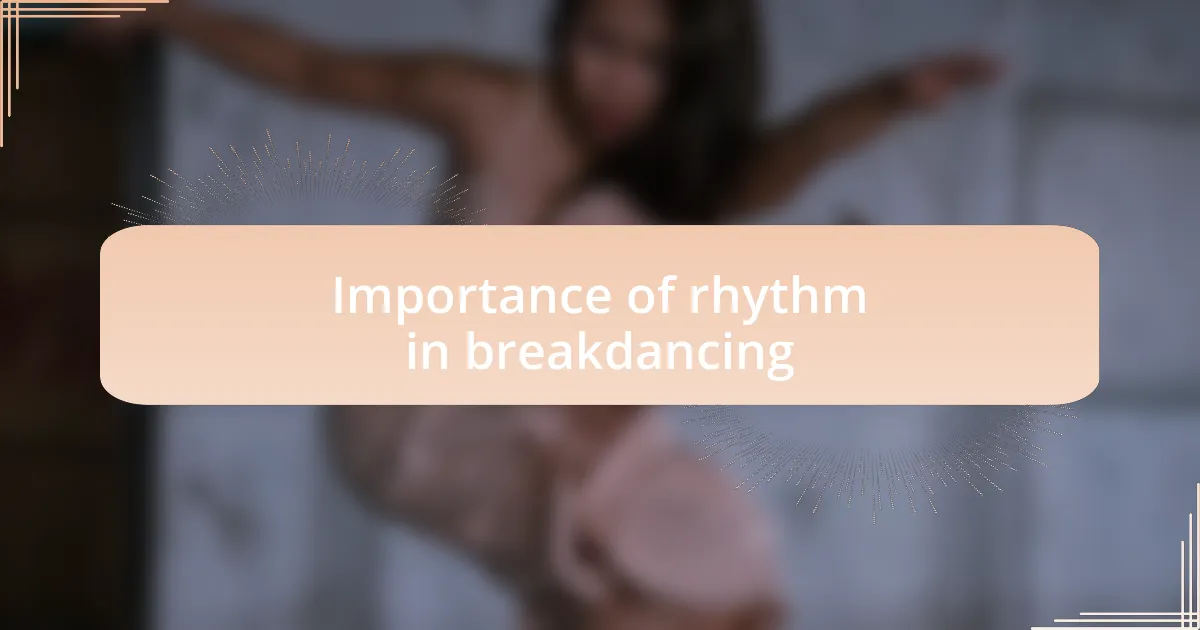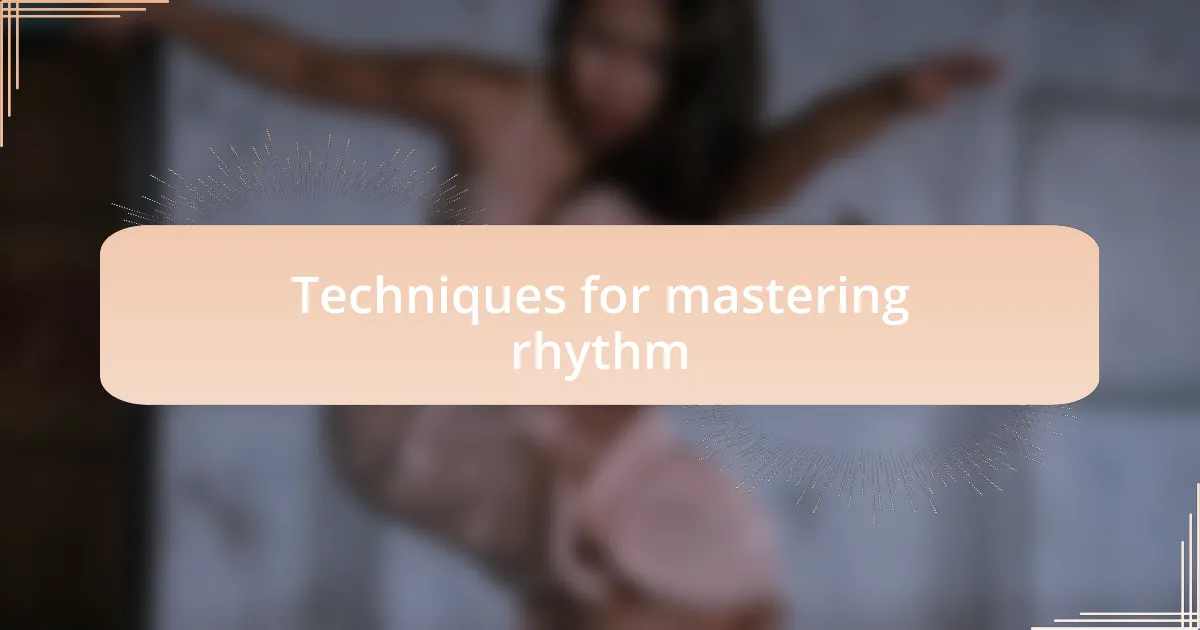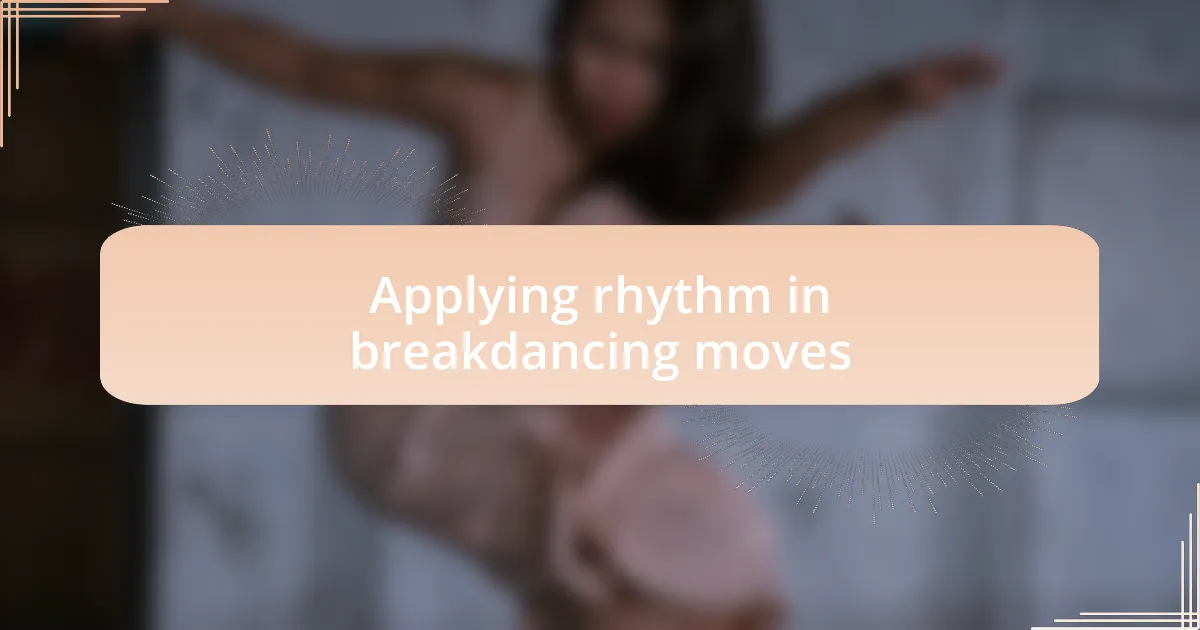Key takeaways:
- Rhythm is the essential foundation of dance, deeply influencing personal expression and creativity.
- In breakdancing, a dancer’s connection to rhythm transforms their performance, making it electrifying and emotionally resonant.
- Mastering rhythm involves listening to music, practicing with tools like a metronome, and experimenting with diverse musical styles.
- Incorporating pauses and adapting movements to song nuances enhances performance impact, creating a stronger connection with the audience.

Understanding rhythm in dance
Rhythm in dance is a fundamental element that serves as the heartbeat of the movement. When I first started breakdancing, I vividly remember struggling to find my groove, feeling awkward and out of sync with the music. But then, something clicked; I began to listen intently to the beats and the spaces in between, and it transformed my entire approach to dancing.
Understanding rhythm goes beyond just following a beat; it’s about feeling the music in your bones. I’ve often found myself lost in the sound, letting it guide my body naturally. Have you ever felt like the music was pulling you into a dance? That connection is powerful—it’s where creativity flourishes and personal expression thrives.
As I’ve continued to explore various styles and techniques, I’ve learned that rhythm is not just a structured pattern but also a fluid conversation between the dancer and the music. There are moments when a pause can be just as impactful as a move; that’s when I feel the audience’s energy shifting. Have you noticed how a well-timed freeze or a spin can elevate a performance? It’s in these moments that rhythm truly becomes an expressive language, telling a story beyond words.

Importance of rhythm in breakdancing
The importance of rhythm in breakdancing cannot be overstated. For me, rhythm acts as the foundation upon which every move is built. There were times when I executed complicated spins and freezes flawlessly, but if I missed the beat, my entire performance felt flat. Have you ever witnessed a b-boy completely lose themselves in the music? It’s mesmerizing because their connection to rhythm transforms their dancing into something electrifying.
Adding variations to my moves while staying in sync with the rhythm has allowed me to express my individuality. I remember during a cypher, I hit a move that wasn’t part of my planned routine, simply because the music inspired me. That moment ignited an energy in the circle that was palpable; it felt like we were all experiencing the same exhilarating lift. Is there any better feeling than being in harmony with both the music and the crowd?
When I practice, I often focus on how rhythmic nuances influence the storytelling in my dance. The way I incorporate accents and syncopations can convey different emotions—sometimes confidence, other times vulnerability. Breaking down the beat, I’ve learned to anticipate the changes, and this anticipation allows me to surprise myself and my audience with unexpected transitions. Isn’t it fascinating how rhythm helps us articulate what words often cannot?

Techniques for mastering rhythm
Mastering rhythm in breakdancing involves a blend of listening and feeling the beats. I remember when I first started, I used to just focus on my footwork, but then I began to really listen to the music. This shift helped me align my movements with the rhythm, making my dance flow more fluidly. Have you ever noticed how certain tracks just make you want to move differently? That’s the power of rhythm.
Another key technique I’ve utilized is practicing with a metronome. This tool made me more aware of timing, pushing me to stay locked in with the tempo. The challenge of hitting each mark taught me consistency in my transitions and provided a foundation for my improvisation. It’s like having a heartbeat driving my performance. Has using a metronome ever sparked a breakthrough for you?
Lastly, I often take time during my sessions to experiment with different styles of music. Jazz, hip-hop, and even electronic sounds each carry their own unique rhythms, and exploring these has enriched my understanding of movement. I remember trying to break to some old-school jazz and feeling completely transformed—each bounce and accent felt like playing an instrument. Isn’t it amazing how diversifying your rhythm sources can elevate your dance to new heights?

Applying rhythm in breakdancing moves
Applying rhythm in breakdancing moves requires a deep connection to the music. I vividly recall a moment during a cypher when a particularly infectious beat dropped, and my body just responded instinctively. It was as if the rhythm had taken over, guiding my movements and allowing me to execute my spins and freezes with an energy I’d never felt before. Have you experienced that captivating connection between music and movement?
Incorporating pauses in my routines has been another way I’ve applied rhythm effectively. I remember a time when I deliberately slowed down my footwork during a high-energy track, creating a striking contrast that highlighted my movements. This intentional use of silence not only captivated the audience but also gave me a moment to gather my thoughts and transition smoothly into the next explosive move. Isn’t it interesting how the space between beats can be just as powerful as the music itself?
Moreover, adapting my moves to fit the nuances of a song greatly enhances my performance. For instance, I’ve found that some tracks have sudden breaks or drops, which I like to interpret through sharp, dynamic movements. I once performed a sequence where I mirrored the growing intensity of a song, landing hard on the beat drop, and it felt like the crowd was riding that wave with me. Have you ever tried playing with such dynamics in your own routines? It can elevate your dancing to an emotional level that truly resonates with both you and your audience.